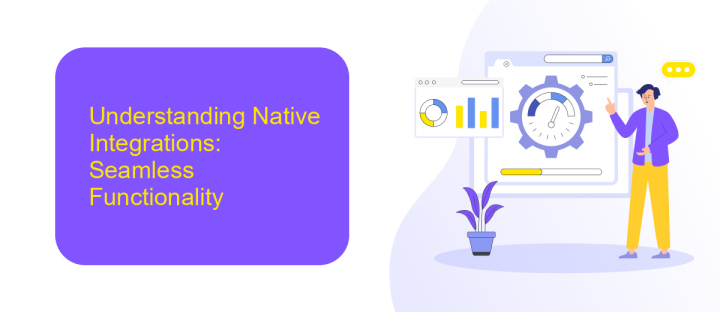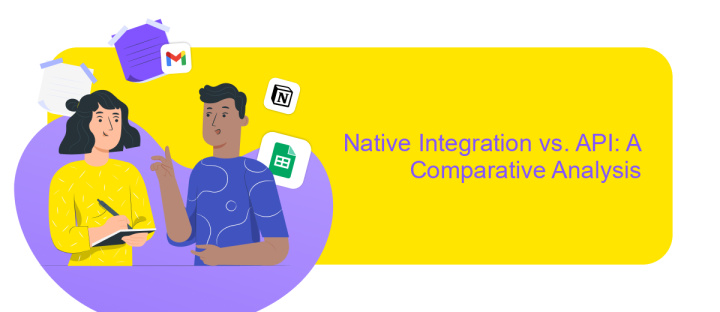Native Integration vs API
In today's rapidly evolving digital landscape, businesses face the critical decision of choosing between native integration and API-based solutions. Native integration offers seamless, out-of-the-box connectivity within a specific ecosystem, ensuring optimal performance and user experience. Conversely, APIs provide flexibility and scalability, enabling diverse applications to communicate across platforms. This article explores the advantages and challenges of both approaches, guiding organizations in making informed integration choices.
Introduction: Bridging the Gap Between Applications
In today's rapidly evolving technological landscape, seamless communication between applications is crucial for business success. As organizations strive to create cohesive digital ecosystems, they often face the challenge of choosing between native integration and API-based solutions. Each approach offers distinct advantages and potential drawbacks, making it essential for decision-makers to understand their unique characteristics and implications.
- Native Integration: Offers deep connectivity and optimized performance by leveraging built-in functionalities within the applications.
- API (Application Programming Interface): Provides flexibility and scalability by allowing different software systems to communicate through standardized protocols.
Both native integration and API solutions serve the ultimate goal of bridging the gap between disparate systems, enhancing interoperability, and streamlining workflows. While native integration might offer a more seamless user experience, APIs provide the agility needed to adapt to changing business requirements. Understanding these differences is key to selecting the right strategy that aligns with organizational goals and technological infrastructure. By carefully evaluating the pros and cons of each option, businesses can ensure more efficient and effective application connectivity.
Understanding Native Integrations: Seamless Functionality

Native integrations are designed to offer seamless functionality by allowing different software systems to communicate and work together without the need for additional middleware. These integrations are built directly into the software, ensuring that data flows smoothly between applications, enhancing user experience and operational efficiency. By leveraging native integrations, businesses can eliminate the complexities often associated with third-party solutions, thus reducing the risk of errors and improving the reliability of their tech stack.
One of the significant advantages of native integrations is their ability to provide real-time data synchronization, which is crucial for maintaining up-to-date information across platforms. Services like ApiX-Drive facilitate these integrations by offering tools that simplify the process, allowing businesses to connect their applications effortlessly. With ApiX-Drive, users can automate workflows and ensure that their systems are always in sync, thus saving time and resources while focusing on more strategic initiatives. This seamless integration capability is vital for businesses looking to streamline their operations and enhance productivity.
Exploring APIs: Flexible Connectivity and Data Exchange

APIs, or Application Programming Interfaces, serve as a bridge between different software applications, allowing them to communicate and exchange data seamlessly. They provide a flexible solution for connectivity, enabling businesses to integrate various services without the need for extensive custom development. By using APIs, companies can enhance their systems' capabilities, streamline operations, and improve user experiences. APIs are particularly useful in today's digital ecosystem, where agility and adaptability are paramount.
- APIs allow for real-time data exchange, ensuring that information is always up-to-date across connected systems.
- They offer scalability, enabling businesses to expand their services and integrate new functionalities as needed.
- APIs enhance interoperability, allowing different platforms and applications to work together efficiently.
- They provide security features like authentication and encryption to protect data during transfer.
- APIs reduce development time by allowing developers to leverage existing functionalities instead of building from scratch.
Incorporating APIs into business operations allows for more dynamic and responsive systems. As companies strive to remain competitive, the ability to quickly adapt and integrate new technologies becomes crucial. APIs offer a cost-effective and efficient means to achieve this, enabling businesses to focus on innovation and growth. By leveraging APIs, organizations can ensure they remain at the forefront of technological advancements, meeting the evolving needs of their customers.
Native Integration vs. API: A Comparative Analysis

In today's digital landscape, businesses often face the decision between native integration and API solutions. Native integration involves building custom connections directly into a platform, ensuring seamless and efficient communication between systems. This approach often results in more reliable and faster performance, as it is tailored to the specific needs of the software.
On the other hand, APIs offer a more flexible and scalable solution. By using APIs, businesses can connect various applications and services without the need for extensive custom coding. This method is particularly beneficial for organizations that require quick adaptability and integration with multiple third-party services.
- Native integration provides optimized performance but requires more development resources.
- APIs offer flexibility and scalability, allowing for rapid integration with various services.
- Maintenance and updates are typically easier with APIs due to standardized protocols.
Ultimately, the choice between native integration and APIs depends on the specific requirements and resources of a business. While native integration may offer superior performance for particular use cases, APIs provide a versatile and cost-effective solution for connecting diverse systems. Organizations must weigh these factors to determine the best approach for their needs.


Choosing the Right Approach: Factors to Consider
When deciding between native integration and API-based solutions, several factors should guide your choice. First, consider the complexity of your project. Native integrations often offer seamless connectivity with minimal setup, making them ideal for straightforward tasks. However, if your project requires more customization or involves multiple systems, APIs provide greater flexibility and control. Evaluate the technical expertise of your team as well; native integrations might be easier for those with limited technical skills, whereas API solutions could require more advanced knowledge.
Another crucial factor is the scalability of your integration. If your business is poised for growth, APIs can offer the adaptability needed to scale operations efficiently. Additionally, assess the cost implications of each approach. While native integrations may have lower initial costs, APIs can be more cost-effective in the long run due to their adaptability. Services like ApiX-Drive can simplify API management, offering user-friendly interfaces and automation capabilities to streamline the integration process. Ultimately, the right choice depends on balancing these factors with your specific business needs and goals.
FAQ
What is the difference between native integration and API integration?
When should I choose native integration over API integration?
What are the benefits of using API integration?
Are there any tools that can simplify API integration for non-developers?
How does using a service like ApiX-Drive help with integrations?
Apix-Drive will help optimize business processes, save you from a lot of routine tasks and unnecessary costs for automation, attracting additional specialists. Try setting up a free test connection with ApiX-Drive and see for yourself. Now you have to think about where to invest the freed time and money!

